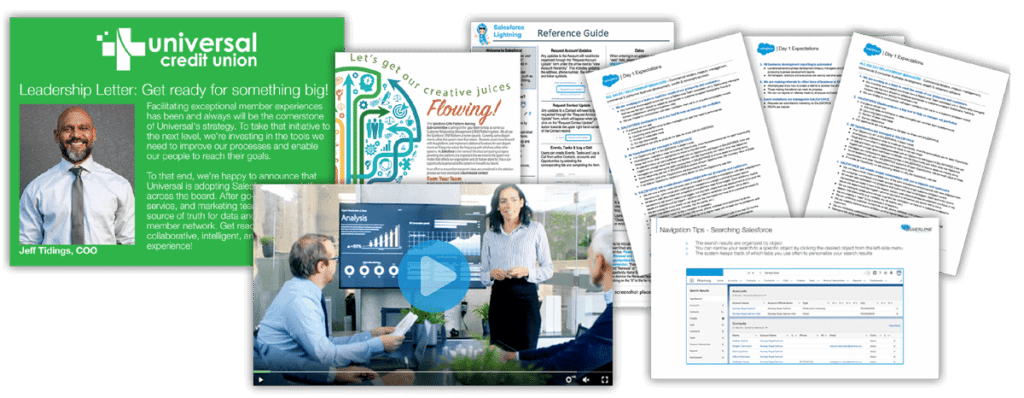This is part four in a series on unlocking change management mysteries. Check out the first, second, and third pieces.
Silverline developed our change management framework based on a combination of industry best practices, the Association of Change Management Professionals (ACMP) Standard, and the Prosci methodology that accelerates and maximizes user adoption. The framework comes down to three phases, the third of which is reinforcement.
Change management is an ongoing process. Continue to reinforce the change and respond to feedback as adoption increases.
Reinforcement Phase: Bolstering and Sustaining Change
Change is hard.
We know this, but when you’re heads-down on a project, understanding why you’re doing it and who it’s for, it can be tempting to move on right away once it’s completed. But change management requires sustained momentum so that your team feels engaged, supported, and heard as they embark upon using a new system. You want to keep up the momentum you’ve achieved with planning and implementing.
The reinforcement phase of an ongoing change management journey allows you to reap the benefits of your digital transformation as quickly and effectively as possible, and collect feedback on what you can do to improve.
4 Ways to Manage Change Post Go-Live
Effective change management requires ongoing actions and check-ins as the team begins to work in the new environment. Successful reinforcement looks like:
1. Monitoring quantitative outcomes
You’re only as successful as your data.
That’s why monitoring the outcomes of your digital transformation is critical. Which metrics you choose depend on your industry and goals, like customer interactions, leads, referrals, close rates, win/close ratios, and customer retention.
Building a set of comprehensive dashboards can help your team see at-a-glance what’s working and what’s not, so you can continue to iterate. Not only does it give you a sense of your project outcomes, but also how well the system is adopted within your team.

2. Gathering and responding to feedback
Dashboards don’t capture everything.
You’ll also want to pursue qualitative feedback. How are people feeling about the change? What does their new day-to-day look like? How confident are they in using the new system?
Talk to your team. You can do this on a 1:1 level for smaller teams, or put together polls, surveys, and informal roundtables to talk about what’s changing, what’s working, and what’s not. Once you gather and respond to feedback, you can recommend and implement course corrections or additional support — and evaluate your next steps on your Salesforce journey.
3. Supporting the team
Change management is all about the people. Now’s the time to actively support your team in adopting the change, by reinforcing what’s changing through communications, training and coaching your team on the new features and systems, and following up with ongoing touchpoints and training. This also includes best practices like:
Ongoing training/coaching: Plan for ongoing refreshers, “office hours”, day-to-day champion support along with easily consumable training tips and usage guidelines.
Hypercare support: Whenever you launch something new, you’ll want to make sure you’re ready to support the team with whatever they need. In the first 90 days, plan for extra hands-on support, whether that’s live chat, office hours, or “walk arounds” to help answer questions as they come up.
Steady state support: From hypercare support, you can transition to a steady state. Once your team is proficient in the system, you can move to a standard support model by providing refreshers and ongoing training for new features and enhancements and onboarding new hires.

There are many ways to celebrate and communicate the coming changes. From executive announcements and manager communications to training decks, quick reference guides, or even a contest to name the new system — extra effort to build excitement goes a long way.
4. Celebrating success
Finally, don’t forget to celebrate! A project like this is no small feat. Your team has put in hours of effort to make this happen, so whether it’s through thank-you notes, shout-outs on your internal company social media, a big launch party or just having a happy hour (or two), take a moment of gratitude and pride for your hard work.
Change Management Matters
It takes time, effort, and dedication to do the “soft skills” type of work that ensures successful adoption of your digital transformation initiative. A successful project incorporates change management early and often, rather than as an afterthought. Your specific approach can and should be tailored to meet the size and scope of your change, but it’s critical as you embark on digital transformation projects.
Research has proven that committing to and effectively applying a structured and methodical approach to change management throughout your initiative significantly increases the likelihood of success. As Ruth Bader Ginsburg said, “real change, enduring change, happens one step at a time.”
Remember that any change management will help your project, even if you can’t do it all.
If you’re inexperienced with change management, engage an expert to help you — we have more than 10 years of experience making sure clients get the most out of their technology. That’s exactly what Silverline can help with. Our work is passionately focused on ensuring successful end-user adoption of the awesome solutions Silverline builds.
And if you haven’t applied your existing change management to your digital transformation, we can help with that, too. We’ve unlocked the mystery of change management and we’re ready to help you with whatever you need.
Ready to make lasting, impactful change for your org? Get your copy of Unlocking the Mystery of Change Management now.





